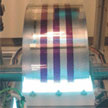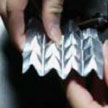Showing Spotlights 9 - 16 of 40 in category All (newest first):
 White-light-emitting diodes have many advantages over forms of lighting - incandescent, fluorescent and halogen - and this solid-state lighting technique is bound to make major inroads into the commercial and household markets. Researchers have now designed precursors and chemical processes to synthesize intercrossed carbon nanomaterials with relatively pure hydroxy surface states for the first time, which enable them to overcome the aggregation-induced quenching (AIQ) effect, and to emit stable yellow-orange luminescence in both colloidal and solid states.
White-light-emitting diodes have many advantages over forms of lighting - incandescent, fluorescent and halogen - and this solid-state lighting technique is bound to make major inroads into the commercial and household markets. Researchers have now designed precursors and chemical processes to synthesize intercrossed carbon nanomaterials with relatively pure hydroxy surface states for the first time, which enable them to overcome the aggregation-induced quenching (AIQ) effect, and to emit stable yellow-orange luminescence in both colloidal and solid states.
Nov 25th, 2014
 Electrochromic devices are some of the most attractive candidates for paper-like displays, so called electronic paper, which will be the next generation display. Researchers have now demonstrated solid state flexible polymer based electrochromic devices are fabricated continuously by stacking layers in one direction. This novel bottom-up approach with no need for a lamination step enables fully printed and 2D patterned organic electrochromics.
Electrochromic devices are some of the most attractive candidates for paper-like displays, so called electronic paper, which will be the next generation display. Researchers have now demonstrated solid state flexible polymer based electrochromic devices are fabricated continuously by stacking layers in one direction. This novel bottom-up approach with no need for a lamination step enables fully printed and 2D patterned organic electrochromics.
Sep 17th, 2014
 In order to fabricate entirely flexible electronic devices, the components that power them - such as batteries - not only need to be fully flexible as well but they have to be compatible with commercially available manufacturing technologies. This would require achieving a high degree of deformability without using elastomeric materials. Researchers have now demonstrated the fabrication of a highly deformable lithium-ion battery using standard electrodes and commercially standard packaging technologies.
In order to fabricate entirely flexible electronic devices, the components that power them - such as batteries - not only need to be fully flexible as well but they have to be compatible with commercially available manufacturing technologies. This would require achieving a high degree of deformability without using elastomeric materials. Researchers have now demonstrated the fabrication of a highly deformable lithium-ion battery using standard electrodes and commercially standard packaging technologies.
Feb 7th, 2014
 Researchers have exploited the extraordinary electrical and mechanical properties of graphene to create a very efficient electrical/sound transducer. This experimental graphene loudspeaker, without any optimized acoustic design, is simple to make and already performs comparably to or better than similar sized commercial counterparts, and with much lower power consumption. Most speakers available today reproduce sound via a mechanical diaphragm, which is displaced oscillatorily during operation. A wide-band audio speaker typically requires significant damping to broaden the response. Even without optimization, the graphene speaker is able to produce frequency response across the whole audible region, comparable or superior to performance of conventional-design commercial counterparts.
Researchers have exploited the extraordinary electrical and mechanical properties of graphene to create a very efficient electrical/sound transducer. This experimental graphene loudspeaker, without any optimized acoustic design, is simple to make and already performs comparably to or better than similar sized commercial counterparts, and with much lower power consumption. Most speakers available today reproduce sound via a mechanical diaphragm, which is displaced oscillatorily during operation. A wide-band audio speaker typically requires significant damping to broaden the response. Even without optimization, the graphene speaker is able to produce frequency response across the whole audible region, comparable or superior to performance of conventional-design commercial counterparts.
Mar 21st, 2013
 Just like other industry sectors, the furniture industry is trying to get more efficient by minimizing material use, minimizing waste, and optimizing energy consumption while improving the performance of their products. Nanotechnology and nanomaterials can play an important role in achieving these goals. A recent project mapped current uses and near future perspective on nanomaterials in the European furniture sector. It looked at innovative materials and potentials of nanotechnology that may positively affect the furniture sector; it also considered possible health risks and steps towards workplace prevention strategies following the precautionary principle.
Just like other industry sectors, the furniture industry is trying to get more efficient by minimizing material use, minimizing waste, and optimizing energy consumption while improving the performance of their products. Nanotechnology and nanomaterials can play an important role in achieving these goals. A recent project mapped current uses and near future perspective on nanomaterials in the European furniture sector. It looked at innovative materials and potentials of nanotechnology that may positively affect the furniture sector; it also considered possible health risks and steps towards workplace prevention strategies following the precautionary principle.
Mar 7th, 2013
 Labelling is a central regulatory tool for risk governance. It aims at meeting a number of goals: It should enable consumers to make informed purchase decisions, avoid consumers being misled and promote innovation. Hence, consumers take part in the risk management of different product groups. Labelling of nanotechnology products has been part of the early discussion on nanotechnology regulation, both at national and EU level. Member states have refrained from independent national initiatives. However, nano-specific labelling obligations have been adopted in European law for cosmetics, food and biocidal products. In contrast, international initiatives for voluntary labelling have not succeeded on the market.
Labelling is a central regulatory tool for risk governance. It aims at meeting a number of goals: It should enable consumers to make informed purchase decisions, avoid consumers being misled and promote innovation. Hence, consumers take part in the risk management of different product groups. Labelling of nanotechnology products has been part of the early discussion on nanotechnology regulation, both at national and EU level. Member states have refrained from independent national initiatives. However, nano-specific labelling obligations have been adopted in European law for cosmetics, food and biocidal products. In contrast, international initiatives for voluntary labelling have not succeeded on the market.
Sep 17th, 2012
 Over the past few years, touchscreens have become ubiquitous in the world of mobile electronic devices. A next generation of touch sensing devices will be vastly more advanced and lead to ultrasensitive artificial skins. Another, novel model for advanced man-machine interactive systems could be based on moisture detectors. Here, actual touch is no longer necessary for a positioning interface to react; rather, the distribution of water molecules that exists around all humid surfaces, such as a human finger, would be sufficient to trigger a response. Researchers in China have now demonstrate such a flexible touchless positioning interface based on the spatial mapping of moisture distribution.
Over the past few years, touchscreens have become ubiquitous in the world of mobile electronic devices. A next generation of touch sensing devices will be vastly more advanced and lead to ultrasensitive artificial skins. Another, novel model for advanced man-machine interactive systems could be based on moisture detectors. Here, actual touch is no longer necessary for a positioning interface to react; rather, the distribution of water molecules that exists around all humid surfaces, such as a human finger, would be sufficient to trigger a response. Researchers in China have now demonstrate such a flexible touchless positioning interface based on the spatial mapping of moisture distribution.
Jul 3rd, 2012
 Risks are high on the agenda in our society, to the extent that we might refer to the society as a risk society. Our society experiences emerging technologies, like nanotechnology. Different actors respond to this in a variety of ways. Among these are the consumers, an important, but neglected category of actors in this context. Arguably it is in our role as consumers we first encountered nanotechnology, in the form of nano-enabled products at the consumers market. What consumers think and do, reacting to the mixed messages about benefits and risks of nanotechnology, contributes to how the risk society (with regard to nanotechnology) is developed, and in that sense becomes operationalized. The theme of this thesis is not just the responses of consumers (and how others perceive these) to the introduction of nanotechnology, but also a case study of how the risk society can be operationalized.
Risks are high on the agenda in our society, to the extent that we might refer to the society as a risk society. Our society experiences emerging technologies, like nanotechnology. Different actors respond to this in a variety of ways. Among these are the consumers, an important, but neglected category of actors in this context. Arguably it is in our role as consumers we first encountered nanotechnology, in the form of nano-enabled products at the consumers market. What consumers think and do, reacting to the mixed messages about benefits and risks of nanotechnology, contributes to how the risk society (with regard to nanotechnology) is developed, and in that sense becomes operationalized. The theme of this thesis is not just the responses of consumers (and how others perceive these) to the introduction of nanotechnology, but also a case study of how the risk society can be operationalized.
May 22nd, 2012
 White-light-emitting diodes have many advantages over forms of lighting - incandescent, fluorescent and halogen - and this solid-state lighting technique is bound to make major inroads into the commercial and household markets. Researchers have now designed precursors and chemical processes to synthesize intercrossed carbon nanomaterials with relatively pure hydroxy surface states for the first time, which enable them to overcome the aggregation-induced quenching (AIQ) effect, and to emit stable yellow-orange luminescence in both colloidal and solid states.
White-light-emitting diodes have many advantages over forms of lighting - incandescent, fluorescent and halogen - and this solid-state lighting technique is bound to make major inroads into the commercial and household markets. Researchers have now designed precursors and chemical processes to synthesize intercrossed carbon nanomaterials with relatively pure hydroxy surface states for the first time, which enable them to overcome the aggregation-induced quenching (AIQ) effect, and to emit stable yellow-orange luminescence in both colloidal and solid states.
 Subscribe to our Nanotechnology Spotlight feed
Subscribe to our Nanotechnology Spotlight feed





